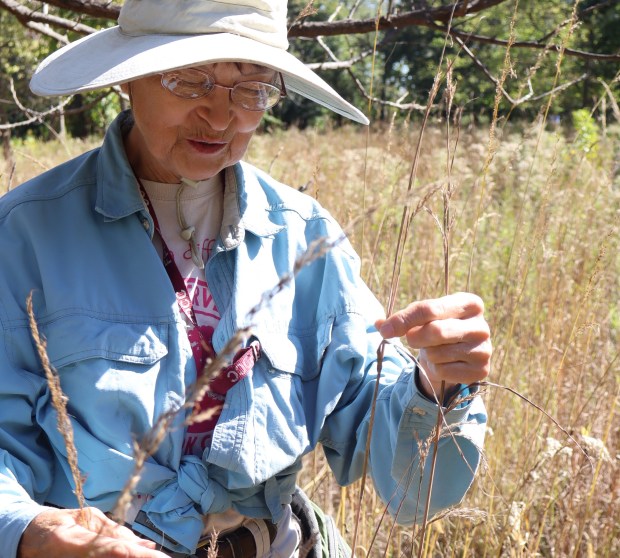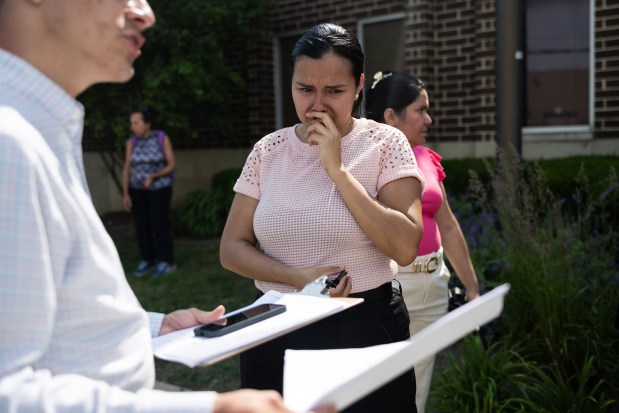Standing in a field of dry native grasses, Marianne Kozlowski pinches a fluffy spike of Indian grass between her thumb and index finger, then pulls. The plant’s soft seeded bristles fall into her cupped hand before she drops them into a plastic bag.
“Touching the tops of Indian grass is like petting a soft kitten,” said Kozlowski, volunteer site steward at Eggers Grove. The Cook County Forest Preserve occupies 240 acres of prairie, woods and wetland on Chicago’s Southeast Side.
As one of 70 volunteer site stewards trained to identify and manage plants for the Forest Preserves of Cook County, Kozlowski is well-versed in the appearance, texture and unique characteristics of just about all flora in the Chicago region. Wearing a broad-brimmed hat, knee high boots and canvas apron, she’s also a meticulous seed custodian.
Kozlowski only harvests a third portion of seed from any plant or plant cluster. She carefully labels seeds according to their common and Latin names, then stores them in an onsite metal shed. The seeds will later be sorted and sown according to each plant’s growth cycle.
Other than authorized staff and volunteers, those who visit the Forest Preserves of Cook County should never take precious seed or plant materials. Kozlowski touts this message and even advises volunteers to remove seeds from clothing before leaving the preserve.
Several times a year — from June through November — Kozlowski oversees volunteer teams numbering two to as many as 30, gathering seeds for repopulating areas of Eggers Grove that have been cleared of invasive plant species.
Dave Schmid, of Chicago’s Beverly community, and Andi Edington, of Munster, Indiana, regularly volunteer, gathering seed and helping to clear away invasives.
“I love being outdoors and making a difference,” Edington said.
While seed gathering may be winding down for 2024, volunteers are still needed for upcoming seed-sorting events, Kozlowski said.
Sand Ridge Nature Center, 15891 Paxton Avenue in South Holland, will be a site for seed processing co-hosted by the Friends of the Forest Preserves from 10 a.m. to 1 p.m. Nov. 2.
Dan Ryan Woods Pavilion, South Western Avenue at 87th Street., will have a seed processing event co-hosted by the Field Museum from 4 to 7 p.m. Dec. 5.
“Both of these Calumet seed processing events will have seeds collected throughout Southeast Cook County,” said Emily Russell, volunteer coordinator for the Forest Preserves of Cook County. “The site steward for each site will bring all the seed they’ve collected throughout the season. We’ll keep the seeds for each site separate so they can be sown back at the site they came from.”
Those sites include Eggers Grove, Beaubien Woods, Kickapoo Woods, Whistler Woods and Sand Ridge Nature Center. Information and registration for the seed-sorting events is at volunteer-fpdcc.givepulse.com.

In 2023, volunteers collected more than 48 pounds of processed seed from 99 plant species, Russell said.
Many of those plants bear common names, like white snakeroot, starry false Solomon’s seal, bellwort, figwort, cat briar, early meadow rue, swamp thistle, hoary vervain and false foxglove.
Kozlowski seems to relish sharing facts about plants as well as their interaction with insects and animals.
The blades of prairie cordgrass are so sharp, she said, they were known for cutting through the coats of passing horses in the 1800s.
Jewelweed, she said, goes by the nickname “touch me not” because its ripe seed pods explode at the slightest touch.
“Seed gathering starts in April with the spring ephemerals,” Kozlowski said. That group includes shorter woodland plants, like mayapple and bloodroot.
Mayapple attracts several species of bee as well as blister beetles. White projections near the plant’s seeds, called elaiosomes, are treats for certain insects.
“To ants, these are like candy,” Kozlowski said. “Ants end up planting the seeds when they carry this back to their colonies.”
Kozlowski frequently consults several books on local native plants. Her favorite reference — Flora of the Chicago Region — rides in the back of her car. She calls the hefty volume, “eight pounds of knowledge.”
For seed gathering, Kozlowski focuses on plants needing to reclaim turf stolen by invasive plants.
Eggers Grove encompasses dune and swale topography unique to areas close to Lake Michigan. Many of the preserves’ hardwood trees, including ancient Chinkapin Oaks, were lost to logging in the late 1800s. Steel mills dumped slag on the preserve’s southern portions. Raised railroad tracks and a Nike missile site upset the natural flow of the marshes and wetlands.

Heavy development also made the land vulnerable to non-native buckthorn, honeysuckle, garlic mustard, purple loosestrife, multiflora rose and mulberry.
“The invasives create depauperate areas — dead zones with plants that don’t support native species of insects and animals,” Kozlowski said. “For a healthy ecosystem with lots of wildlife, you need plants that are blooming throughout the year. You need variety.”
Kozlowski took up restoring that variety 10 years ago, when she retired from her career as a bank systems manager. Thanks to her efforts and those of other volunteers and Forest Preserves staff, several native species of plants, pollinators and birds, including the black crowned night heron, are back.
“We’re not trying to restore the area to what it was in the 1800s,” Kozlowski said. “We’re just trying to help it be the healthiest, most diverse place it can be now.”
Earlier in the summer, Kozlowski, a certified chainsaw fellers assistant, worked with volunteers to clear away woody invasive species in the southern portion Eggers Grove at Wolf Lake Overhang.
More recently, she oversaw 16 students and faculty members from Marist High School in a volunteer effort burning the piles of cut buckthorn and other woody invasives.
Those efforts support regrowth of native big bluestem grass, Joe Pye weed, old world goldenrod, silky rye, bottlebrush grass, nodding wild onion and Indian grass.
Besides nurturing native grasses and sedges, Kozlowski coaxes along several varieties of wild asters, woodland sunflowers, and herbs like wild licorice and mountain mint. She also keeps close tabs on the preserve’s towering oaks and native fruit bearing plants—wild grape, native rose, fruited dogwood and nannyberry.
“If you don’t plant where you just took the bad stuff out, it all comes back,” Kozlowski said. “If the land were open, you could let it take care of itself, but the remnants that are left in Northern Illinois are so small. With the pressures of us, we have to think of this like Native Americans if we want as much species diversity as possible.”
Susan DeGrane is a freelance reporter for the Daily Southtown.





